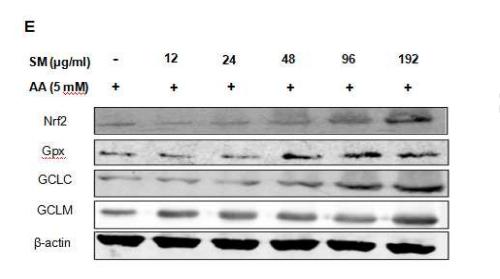GPX1 Antibody - #DF6249
| Product: | GPX1 Antibody |
| Catalog: | DF6249 |
| Description: | Rabbit polyclonal antibody to GPX1 |
| Application: | WB IHC |
| Cited expt.: | WB |
| Reactivity: | Human, Mouse, Rat |
| Prediction: | Pig, Bovine, Horse, Rabbit, Dog, Chicken |
| Mol.Wt.: | 22kDa; 22kD(Calculated). |
| Uniprot: | P07203 |
| RRID: | AB_2838215 |
Related Downloads
Protocols
Product Info
*The optimal dilutions should be determined by the end user. For optimal experimental results, antibody reuse is not recommended.
*Tips:
WB: For western blot detection of denatured protein samples. IHC: For immunohistochemical detection of paraffin sections (IHC-p) or frozen sections (IHC-f) of tissue samples. IF/ICC: For immunofluorescence detection of cell samples. ELISA(peptide): For ELISA detection of antigenic peptide.
Cite Format: Affinity Biosciences Cat# DF6249, RRID:AB_2838215.
Fold/Unfold
AL033363; Cellular glutathione peroxidase; Glutathione peroxidase 1; Glutathione peroxidase; GPx 1; GPx-1; GPX1; GPX1_HUMAN; GPXD; GSHPx-1; GSHPX1; MGC14399; MGC88245;
Immunogens
A synthesized peptide derived from human GPX1, corresponding to a region within the internal amino acids.
- P07203 GPX1_HUMAN:
- Protein BLAST With
- NCBI/
- ExPASy/
- Uniprot
MCAARLAAAAAAAQSVYAFSARPLAGGEPVSLGSLRGKVLLIENVASLUGTTVRDYTQMNELQRRLGPRGLVVLGFPCNQFGHQENAKNEEILNSLKYVRPGGGFEPNFMLFEKCEVNGAGAHPLFAFLREALPAPSDDATALMTDPKLITWSPVCRNDVAWNFEKFLVGPDGVPLRRYSRRFQTIDIEPDIEALLSQGPSCA
Predictions
Score>80(red) has high confidence and is suggested to be used for WB detection. *The prediction model is mainly based on the alignment of immunogen sequences, the results are for reference only, not as the basis of quality assurance.
High(score>80) Medium(80>score>50) Low(score<50) No confidence
Research Backgrounds
Protects the hemoglobin in erythrocytes from oxidative breakdown.
During periods of oxidative stress, Sec-49 may react with a superoxide radical, irreversibly lose hydroselenide and be converted to dehydroalanine.
Cytoplasm.
Belongs to the glutathione peroxidase family.
Research Fields
· Human Diseases > Neurodegenerative diseases > Amyotrophic lateral sclerosis (ALS).
· Human Diseases > Neurodegenerative diseases > Huntington's disease.
· Metabolism > Metabolism of other amino acids > Glutathione metabolism.
· Metabolism > Lipid metabolism > Arachidonic acid metabolism.
· Organismal Systems > Endocrine system > Thyroid hormone synthesis.
References
Application: WB Species: Rat Sample:
Restrictive clause
Affinity Biosciences tests all products strictly. Citations are provided as a resource for additional applications that have not been validated by Affinity Biosciences. Please choose the appropriate format for each application and consult Materials and Methods sections for additional details about the use of any product in these publications.
For Research Use Only.
Not for use in diagnostic or therapeutic procedures. Not for resale. Not for distribution without written consent. Affinity Biosciences will not be held responsible for patent infringement or other violations that may occur with the use of our products. Affinity Biosciences, Affinity Biosciences Logo and all other trademarks are the property of Affinity Biosciences LTD.


